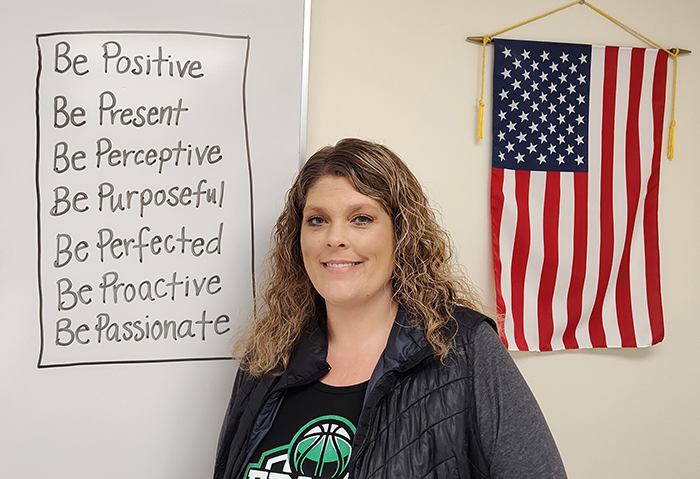Second PCN student survey coming later this month
News | Published on February 13, 2024 at 1:48pm EST | Author: frazeevergas
0Grant focuses on the science of the positive

Positive Community Norms Grant Coordinator Heidi Moen and her coalition are preparing to administer the annual PCN Student Survey to students in sixth through 12th grade.
By Robert Williams
Editor
Students at Frazee-Vergas in sixth through 12th grades will be administered the second Positive Community Norms Grant (PCN) survey on Wednesday, Feb. 21.
The 30-minute survey is completely confidential and has to be done without any assistance, according to PCN Coordinator Heidi Moen.
The survey is part of a research study about student perceptions of the use of substances like alcohol, vaping, tobacco and other drugs.
“We want the kids to know it’s anonymous and completely confidential because we want to know what the kids are seeing for substance abuse or what they are using,” said Moen. “So that we know what we are working with in the community and so we know what they perceive and what they think is actually happening.”
The Frazee-Vergas School District received the PCN grant from the Minnesota Department of Human Services-Behavioral Health Division July of 2021.
Positive Community Norms is based on “the Science of the Positive,” the study of how positive factors impact culture and experience. Positive Community Norms closes the gap between what students believe to be true and what is actually true. By talking about positive behaviors rather than emphasizing negative behavior and inadvertently making that seem common or even attractive, PCN brings forward the message that the positive is the norm.
Between July 2006 and June 2016, two sets of 5-year grants were awarded to independent school districts, local non-profits, local public health departments or to county attorney’s offices. Funds came from the Substance Abuse and Mental Health Services Administration.
In 2016, Minnesota started its third round of funding. Nine new grants funding 10 school districts have been awarded with nearly $9 Million, an average of $200,000 per year each, in grants.
Locally, in the third year of the grant, a student-based steering committee Grow Frazee-Vergas (GFW) continues to work on how to best utilize the funds of the five-year grant to benefit youth in the surrounding community.
Vaping is one of the major issues. Moen shared an example question from the survey and noted that in regards to vaping the perception of use compared to actual use varies dramatically.
“That’s probably the biggest difference in actual data versus perceived,” she said.
Moen took over the PCN Coordinator role last April and since has made a concerted effort to ease student concerns about confidentiality when sharing their answers.
“They were very concerned that if they answered it correctly, because it was on a school-issued computer, that they were going to get in trouble,” said Moen. “I’ve done a lot of educating this year and they know we don’t want them to lie. We want to know the truth, because we want to know what to do and how to help. No school is going to be 100 percent perfect, but you also have to look at – this is a prevention grant, but you also work on harm reduction.”
The survey is not required.
“The more students that do take this the more accurate information that we get,” said Moen.
The survey is also live on the school website for parents who want to examine it before Feb. 21. It can be found at frazee.k12.mn.us/schools/frazee-high-school/
Moen noted that the perception of student usage compared to the reality is a tricky situation. Students involved in activities already proclaim that they are not using when they sign up for anything from robotics to dance. It is part of the Minnesota State High School League bylaws regarding chemical eligibility.
“Look at how many of our kids are in activities,” said Moen.
She also validated concerns about student usage, but cited the PCN push for addressing those issues in a positive manner.
“The one thing you can do is offer support; when you’re ready to quit come and see me and I will get you some support,” she said.
The survey utilizes comparison questions to try to get to the real data, for instance, asking if a student uses e-cigarettes and how often and following up with how many students do you perceive are using and how often.
“Then we have data and the misperception of what they think is going on,” Moen said. “That’s really, in essence, what we’re trying to break down. It sounds crazy, but if 5 percent of that misperception can be broken down in a year and we can get community, family members and kids to all work together for the common good of how we’re going to reduce substance abuse, it’s that; it’s communication, talking, and education.”
Working directly with the students through their group My Voice is Powerful (MVP) and individually has brought both kids and adults together on these issues.
“We’ve made leaps and bounds in the last 10-11 months by letting the kids know that we aren’t going to do anything if you aren’t on board with us,” said Moen. “We want to know how you want to get our messaging out, where you want it, how that helps and how should we deliver it? It doesn’t do any good for me and my coalition to write anything up if the kids don’t think it’s important.”
Moen also noted that many of the students have been working together citing juniors and seniors who work with younger students after sharing that many of them first encountered substances around sixth grade and how important it is to get the messaging to those younger students and how quality interaction with older students can be a positive experience and provide advice in how to deal with those pressures.
More information on the Positive Community Norms grant can be found on the Minnesota Department of Health website mn.gov/dhs

